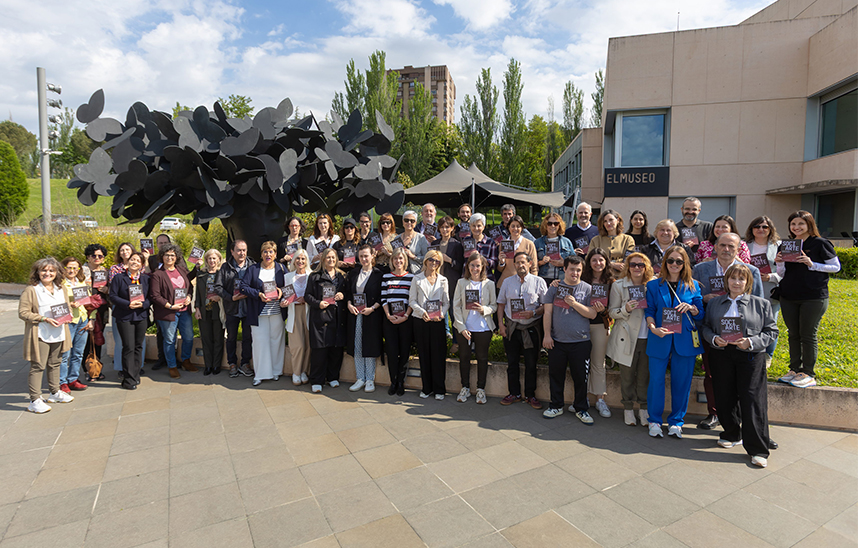The MUN celebrates the 4th edition of "SociARTE" with the 31 participating social entities and the illusion of continuing to grow
Today took place the annual meeting of the MUN with people from the entities that participate in the social innovation program of the Museum, called SociArte, supported by "la Caixa" Foundation.

FotoManuelCastells/MuseoMuseo Universidad de Navarra of the social entities that are part of SociARTE together with MUN professionals.
The Museo Universidad de Navarra considers the link with Navarre's social entities one of its main missions, which it channels through the SociARTE network. Today, Monday 19, has brought together representatives of the 31 associations that make it up, in its fourth edition. For the next edition, it is expected that there will be 35.
SociARTE is the MUN's social program that, with the support of "la Caixa" Foundation, aims to listen to the social entities in Navarre to learn about the needs of the people they bring together and respond to them with art as a resource. As stated by the artistic director of the MUN, Gabriel Pérez-Barreiro, "a museum exists to bring art closer to people". For her part, Izaskun Azcona, delegate of "la Caixa" Foundation in Navarra, maintains that alliances like this one allow consolidating "the support to art and culture as a source of personal and social development. What we continue to pursue," she adds, "is to generate a fairer and more equitable society that leaves no one behind, on this occasion, with the language of contemporary art and its strategies.
Through SociARTE, the MUN makes its resources available free of charge to these groups with special needs, to work in different areas through art and creativity. "We do not conceive of the MUN as a container for pieces, a closed or sacred space where there is only room for one way of looking. The MUN is a space for coexistence," said Daniel Franco, MUN collaborator in charge of coordination with the social entities, "and this is what the participants of SociARTE have taught us: that art cannot stand still, that it needs to move, open up and adapt to new ways of looking and ways of perceiving and understanding existence".
SociARTE is a growing program, edition after edition: this year there were 1,344 participants, compared to 1,075 last year, 630 in the second edition and 354 in the first. The same is true for the number of activities: a total of 87, compared to 63, 35 and 16 in previous editions respectively. It has thus reached its year "of consolidation," as Fernando Echarri, head of the MUN's Educational area, has stated. "SociARTE is already a network," he added, dedicated to "co-creating" activities with the associations that are of real value to them, based on listening and "walking together".
The proposals, among others, include contemplation and visual thinking activities, creative activities, workshops for children and teenagers, urban camps, family and adult workshops, film forums, attendance at performances of the cycle Museo en DanzaThe program also includes training sessions for employees of social organizations, art therapy meetings, and the creation of accessible, multisensory and inclusive materials so that people with disabilities can enjoy art.
The IV edition closes with 31 entities, to which Itaka-Escolapios and three other associations will be added soon: ACODIFNA (Coordinating Association of People with Physical Disabilities of Navarra), ADEMNA (Multiple Sclerosis Association of Navarra), ADHI (Navarra Association for the Treatment and Study of Attention Deficit, Hyperactivity and Impulsivity), AEES (Spanish Association of Sensitive Education), AFAN (Association of Relatives of People with Alzheimer's and other Dementias of Navarra), ALCER NAVARRA (Association for the Fight against Renal Disease), AMEDNA/NEEZE (Association of Women Entrepreneurs and Executives of Navarra), AMUDISNA (Association of Women with Disabilities of Navarra), ANAC (Navarra Association for High Abilities), ANADI (Navarra Diabetes Association), ANAPAR (Navarra Parkinson's Association), ANDI (New Dialogue Association), ANELA (Navarre ALS Association), ANFAS (Navarre Association for Persons with Intellectual and Developmental Disabilities and their Families), ANNF (Navarre New Future Association), ASDN (Navarre Down Syndrome Association), AR (Roncal Association), ASORNA (Navarre Association of Deaf People), Bilaketa, Besarkada - Abrazo, CEAR (Spanish Commission for Refugee Aid), Core Milagrosa Foundation, DISNAVARRA (Navarra Dyslexia Association), Eunate (Navarra Association of Families of Deaf People), FIHB (Ilundáin Haritz-Berri Foundation), ALAN (Asociación Luciérnaga - Asperger Navarra), Onabide Association, ONCE (Spanish National Organization for the Blind), Irati River Center - Caja Navarra Foundation, Saray (Navarra Breast Cancer Association) and Xilema Foundation.
A workshop for nursing mothers
As a continuation of the MUN's support to the social entities of Navarre and, specifically, to Amagintza, last Saturday, the 17th, it held the contemplation workshop "My Milky Way", aimed at nursing mothers and their babies. In addition, the MUN encourages nursing mothers who visit its galleries to feel free to breastfeed their babies in different places: the meeting point, the restaurant terrace or the exhibition halls themselves, for example.
The activity took place in front of a photograph belonging to the MUN collection that captures the theme of this workshop: Maria, Joao & Isaac (2013), by French photographer Pierre Gonnord -a photographer of international relevance who died in 2024-, which portrays a gypsy mother breastfeeding her twins. It is part of De laboris ( 2016 exhibition), a work dedicated to the miners of the Asturian-Leonese basin and the gypsy collective of La Raya, on the border between Spain and Portugal, which the Frenchman did in artistic residence at the Museum (in the program Tender Puentes).
Teresa Torres, facilitator of the workshop, highlights the "intimate space" that was created during the proposal. She also conveys very positive impressions from some of the participants, such as the pleasure of being able to carry out this activity in a museum and thus break down some external and internal barriers, often self-imposed, and thus live the reality of this period of motherhood "naturally", in new adapted spaces, in places that perhaps one had discarded beforehand.